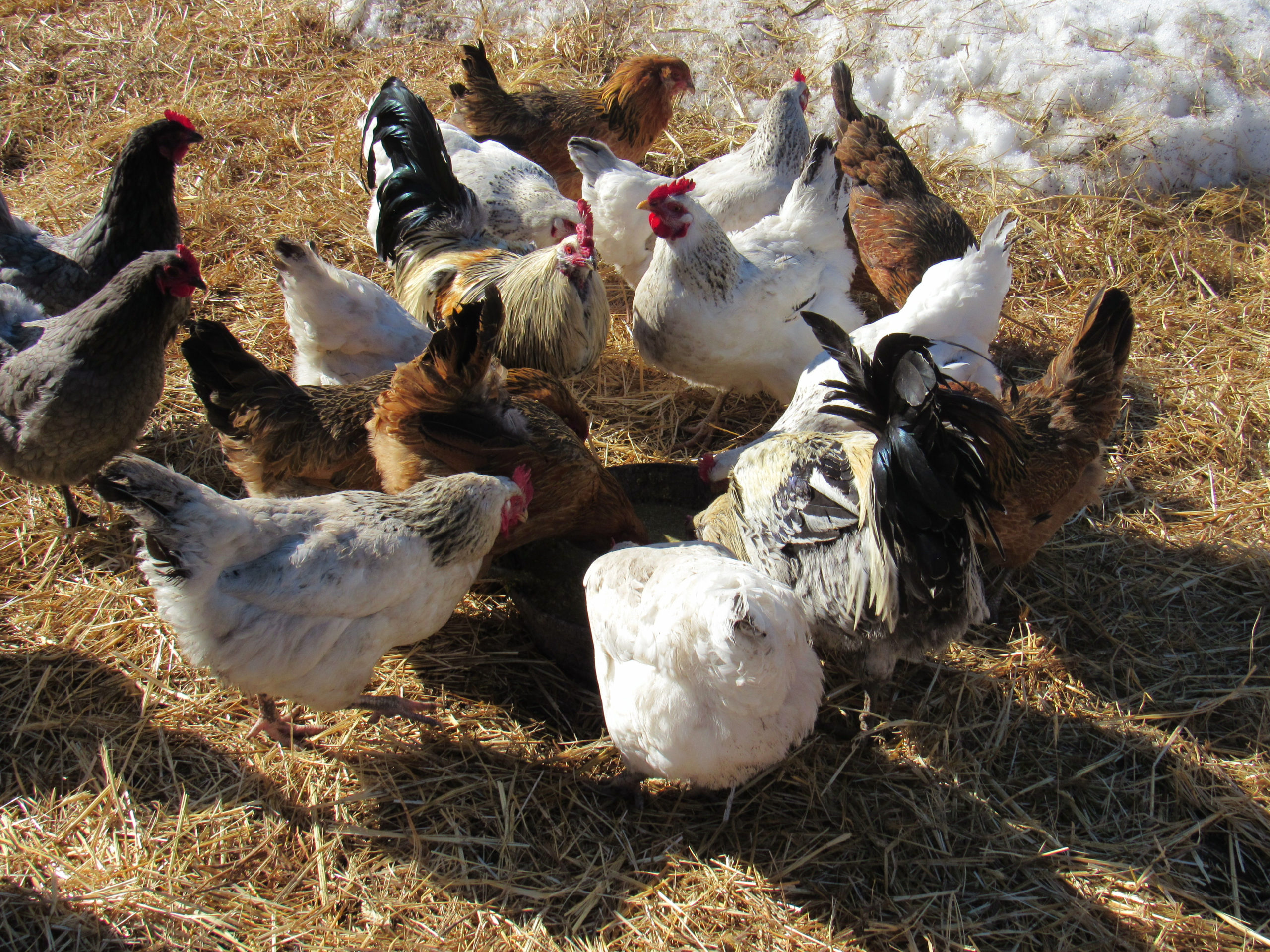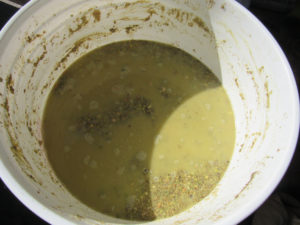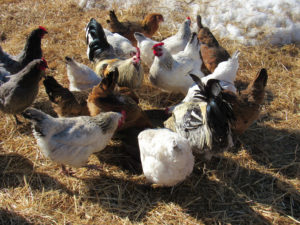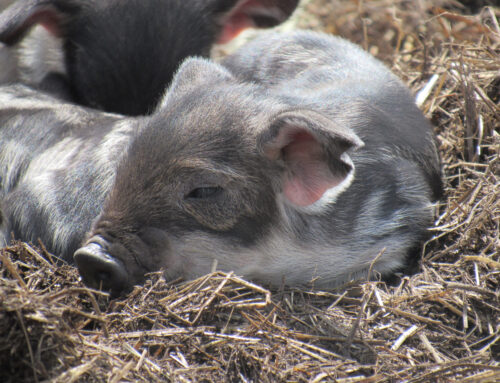We rely on our livestock to provide us with nutrient-dense food, so giving them the best nutrition possible is high on our priority list. Enter fermentation. If you know us at all, you know how highly we esteem the health benefits of traditionally Lacto-fermented vegetables and bread! Those health benefits can be translated directly across to herbivore and omnivore livestock, too. Our foray into fermenting feed for the Ranch livestock began while doing research on feeding pigs (shhh!)
We started fermenting feed for our laying hens, very pregnant Alpine dairy goats, and their future milking stand ration. The reasons we undertook to do so are manyfold. First, fermenting grains and legumes transforms them into superfoods for our stock as it:
- Destroys enzyme inhibitors
- Neutralizes phytates
- Converts starch to sugar (which is better for ruminants)
- Increases enzymes, protein, vitamin levels, amino acids, and fatty acids
- Adds natural probiotics
- Improves digestion, nutrient absorption, and palatability
- Increases the conversion rate of grain to weight gain
- Weight gain is in muscle, not fat
Second, we go to great lengths to avoid feeding genetically modified (GM) crops such as corn and soy. Third, rolled or cracked grains go rancid very quickly. When that happens, the body treats them as toxins which can adversely affect the health of an animal. Fourth, buying whole grains and legumes in bulk is more economical than buying pre-mixed feeds, and we have more control over what they eat.
The small amount of time and effort involved in four easy steps is well worth it! It only takes simple everyday items, a few minutes to mix up a batch, and a couple of days to ferment. Not to mention, it makes your animals healthier, their eggs, milk, and meat even more nourishing. What’s not to love about that!
What is Lacto-Fermentation?
Fermenting involves a natural chemical process that breaks down a complicated food substance into simpler parts with the help of Lactobacillus bacteria. There are various strains of Lactobacillus bacteria that are present on the surface of all plants and also in the gastrointestinal tract and mouth of humans and animals. Lactobacillus bacteria have the ability to convert sugars into lactic acid through this naturally occurring fermentation process.
The Lactobacillus converts starch and sugar resulting in a feed that is rich in lactic and acetic acids with a reduced pH that encourages the formation of natural probiotics. Fermented food is considered live food.
Lactic acid is a natural preservative that inhibits the growth of harmful bacteria. Historically, this allowed people to preserve foods for extended periods of time before refrigeration or canning. Lactobacillus organisms produce antibiotic and anti-carcinogenic substances. So as lactic acid increases during the fermentation process, the possibility of contamination from harmful bacteria (coliform) is eliminated.
Hydration of grains also results in enzymatic action that reduces enzyme-inhibitors which block the absorption of nutrients.
Enzymes play a major role in breaking down fiber and anti-nutrients. If you can use an enzyme-rich cultured dairy product like kefir, buttermilk, or yogurt (even sourdough starter!) as a starter culture it will accelerate the fermentation process.
Health Benefits
When an animal is under stress, molting, or under the weather the extra nutritional support from the fermented feed is very helpful.
Improves Digestion and Nutrient Absorption
If you know just a little bit about the digestion of grains you know that most animals can’t break them down and utilize the nutrients, often passing through the digestive system still whole. Essentially, all grains, seeds, nuts, beans, and other legumes are plant seeds. As such they contain protective elements in their outer seed coat and bran to protect them from insects and environmental threats. These include phytic acid, lectins, enzyme-inhibitors, and fiber in the bran that are difficult to break down in the digestive tract. Phytic acid is referred to as an “anti-nutrient” because it binds with minerals in the grain impairing their absorption in the digestive tract.
However, fermenting grain makes it easier for animals to digest and utilize the nutrients they are consuming! The warm, moist fermentation “brine” mimics the natural germination process wherein anti-nutrients are neutralized. This acidic environment also helps break down the hard-to-digest fibers, basically pre-digesting the grain.
Fermentation has been shown to enhance the content of vitamins such as B, C, A, and E, as well as to increase the protein, fat, and amino acid composition. It also increases antioxidants and has an alkalinizing effect on all body cells.
The lactic acid bacteria have a stimulating effect on the gut health of the animals which helps keep them healthy. Feed acidity is also hostile to pathogens in the gut, so medications and antibiotics become redundant.
Adds Natural Probiotics
As lactic acid bacteria ferment the grains, beneficial bacteria populations bloom resulting in natural probiotics that are stellar for digestion! And as you know, gut health directly impacts total body health.
Studies show that animals who receive probiotics through fermented feed have more robust health than those on dry feed diets. Another study found that the levels of lactic acid bacteria in fermented chicken feed lower the pH of chicken’s intestines enough to ward off acid-sensitive bacteria like E.coli and Salmonella.
Better Quality Meat, Milk, & Eggs
A study in the Journal of British Poultry science concluded that chickens given fermented feed showed increased egg weight, shell thickness, and shell stiffness. This means chickens are less likely to have soft-shelled eggs or become egg-bound, both of which can be life-threatening.
And remember, just like humans, livestock are what they eat. So if they receive superior nutrition like fermented feed their meat, milk, and eggs will be supremely nourishing for you in return!
Talking About Feed Costs
As grains soak in water to ferment, they expand in volume. A lot. So your animals get full faster, but this isn’t filling them up on poor junk food. Rather, they get more nutrients than ever and stay satisfied longer! On the fermented feed, our chickens eat a minimum of one-third less per day. Your mileage may vary, but so far we are quite impressed.
We all know that chickens rarely clean up all of their dry feed. Well, when it’s fermented they do! Yep, zero wasted feed. When does that ever happen with livestock?
Fermenting your livestock feed improves the nutritional value of economical whole grains while they also consume and waste less. That’s a clear win-win in our book!
How to Use Fermented Feed
To begin, offer less fermented feed than you would their normal dry feed. Remember, because fermented grains are greatly expanded in volume it tends to keep them satisfied longer. Your animals will eat and may even drink less. Just observe what they consume and adjust.
How often you give your livestock fermented feed is up to you. The more the better, in or opinion! Folks who feed it exclusively stagger batches, which is what we do. If you just want to give it as a treat a few times each week, simply start one batch at a time. You’ll figure out your own fermentation rhythm.
For us, one “batch” of fermented feed is two days’ worth. Using some from the current batch as a starter, it takes two days to ferment, depending on the temperatures. As we finish one batch, we start the next one.
The How-to of Fermenting
Step #1: Acquire Feed & Containers
There are two family-owned mills in our region that both certify any potentially GM ingredients. We get pre-mixed mash through them. Or we buy a mixture of whole barley, hard red winter wheat, and oats from a local grower.
You can ferment crumble or pellets but whole grains hold up much better. To begin with, we fermented the mash which worked very well. You can even ferment scratch grains as a treat.
Because fermentation makes the feed slightly acidic, use food-grade plastic if possible. The container needs to be large enough to hold the amount of feed you choose, plus extra room for water, stirring, and lots of expansion (it will be much more than you imagine!) We use 5-gallon buckets for the moderate number of animals we have.
You will also need some type of loose-fitting lid to keep dust and debris out but still allow for fermentation gases to escape.
Step #2: Combine Feed & Water
To get started, pour water into your fermentation container along with any starter culture you will be using, and then slowly add the grains, stirring well. Make sure the feed is fully submerged by a couple of inches.
Starter cultures that can be added are a sourdough starter, kefir, or cultured buttermilk.
Chlorinated water can inhibit healthy fermentation. So if your water supply contains chlorine, simply leave an appropriate amount of water out at room temperature overnight to allow the chlorine to dissipate.
Step #3: Let the Fermentation Begin!
Now place the lid on the container. Set it in a location with a moderate temperature (not hot but not too cold); 63°F seems to be the sweet spot in our cabin. And then let the fermentation begin! Check and stir it every day. Add additional water if the feed has absorbed it all.
By day two or three depending on temperatures, you will see small bubbles on the surface and/or within the feed mixture. Bubbles are a good thing! That means the Lactobacillus bacteria are at work. It will smell tangy or sour, yet somewhat sweet. If there is kelp in your feed, it may smell a little fishy as well. The liquid brine will also become increasingly cloudy.
If the fermented feed develops a putrid odor do not feed it.
Fermented feed is effectively “preserved” due to the low pH, so it’s safe for your animals to consume beyond day three or four. But it gets sourer the longer it ferments, therefore, it can become less palatable. See if your animals have a preference; ours do not.
Step #4: Serve It Up!
When Lacto-fermentation has been achieved, start feeding it to your animals! You can drain some of the brine off by using a mesh kitchen strainer/scoop, but the animals love the brine, too!
You can reserve some of the fermented feed and brine to jumpstart a new batch. The lactic acid bacteria in the brine will happily feed on more grains thus shortening the fermentation time for the next batch. Or drain it onto your garden beds or compost pile.
Before serving it up, we also mix in a bit of kelp, diatomaceous earth (DE), SEA-90 animal mineral salts, and sometimes flax seeds.
And voila, you’ve created a superfood for your livestock! We guarantee they’ll love it!
Keep in mind that the feed will spoil when no longer submerged in its brine. So, if you ferment a lot of feed just scoop out what you need per day with some type of strainer. Or, for a small backyard flock of pet hens, you could refrigerate the unfed portion to halt fermentation.
Easy, Healthy, & Worthwhile
Fermenting livestock feed is an easy way to give your animals a natural health boost. It can lead to healthier animals, more nourishing food products for your family, and lower feed costs.
We noticed harder shells and a more balanced flavor profile of our hens’ eggs.
You can ferment feed for rabbits, chickens, ducks, turkeys, sheep, goats, pigs, and cattle. They’ll all benefit greatly from it versus dry feed. Since poultry don’t have teeth to grind their food, they especially appreciate the soft fermented grains that are gentler on their crop and gizzard.
Give it a try… it’s oh, so worthwhile!
We hope you found this article helpful and interesting! If so, please spread the love by sharing this post.








Hi! I have a question. The feed I’m currently feeding my goats has molasses on it. Can I ferment that or should I wait and get feed without Molasses?
[…] you’re going to feed grain, have you thought about pre-soaking or fermenting it to increase its volume and nutrient density? Soaking partially breaks down grain rations so […]